The Demographic Structure of the Indian Society Class 12 Sociology
Introduction
Demography is the study of population trends and processes, including changes in population size, birth and death patterns, migration, and population structure.
- The word "demography" is derived from the Greek terms "demos" (meaning "people") and "graphein" (meaning "describe"), which suggests that it is concerned with the description of people.
- To conduct demographic studies, counting or enumeration procedures such as censuses or surveys are used to systematically gather information on the population in a given territory.
- Demography is closely related to sociology and has played a significant role in the growth of sociology as an academic discipline. In fact, the beginnings of modern statistics and nation-states in Europe during the late 18th century were instrumental in the development of demography.
- Governments use demographic data to formulate and execute policies, especially those concerning economic growth and general welfare. The numerical properties of aggregate statistics, which represent vast populations containing millions of people, help to identify and explain the presence of social phenomena.
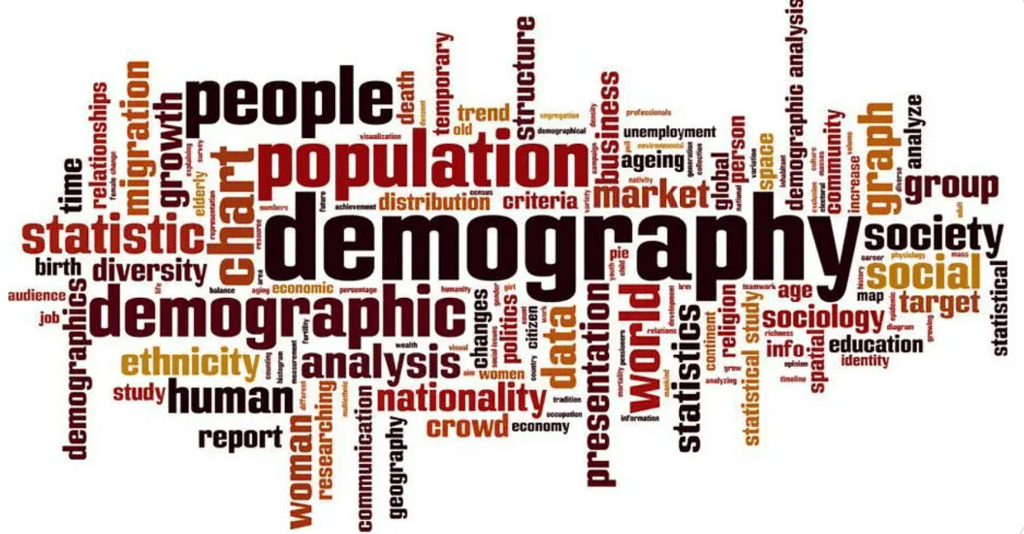
Two forms of demography exist:
- Formal Demography employs statistical analysis of population data, such as the overall population size, gender ratio, ratio of youth to working-age individuals, and rural-urban distribution (based on quantitative data).
- Social Demography concerns a society's migration patterns, birth and death rates, and other demographic factors. It is focused on the consequences of population changes and how they impact society, utilising data, totals, and statistics.
Some Theories and Concepts in Democracy
1. The Malthusian Theories of Population Growth
- Thomas Robert Malthus developed the Malthusian Theory, which argues that human populations grow at a faster rate than the means of human subsistence, such as food, clothing, and other agricultural products.
- Malthus’s theory highlights the challenges of managing population growth and resource production, suggesting that without effective controls, humanity will face ongoing poverty and scarcity due to the inherent imbalance between population growth and agricultural production.
Main Points of the Malthusian theory:
1. Disparity in Growth Rates: Malthus asserts that population growth follows a geometric pattern (e.g., 2, 4, 8, 16), while agricultural output increases only in an arithmetic pattern (e.g., 1, 2, 3, 4). As a result, the population will always outstrip the growth of agricultural production, leading to a perpetual state of poverty.
2. Implications for Prosperity: According to Malthus, the only way to increase prosperity is by controlling population growth, as the expansion of population always outpaces the production of necessary resources.
3. Challenges in Controlling Population: Limiting population growth is difficult because there are only a limited number of "preventive checks" that can be implemented, such as:
- Postponing marriage
- Sexual abstinence or celibacy
4. Role of Natural Checks: Malthus argues that natural checks like famines and diseases are inevitable as they help balance the imbalance between food availability and the growing population.
 Thomas Robert MalthusObjections to the Malthusian Theory
Thomas Robert MalthusObjections to the Malthusian Theory
- Sociologists argue that poverty, hunger, and other social problems are caused by unequal distribution of economic resources, not by a decrease in agricultural productivity.
- The advancement of science and technology has not limited agricultural output.
- As population growth has increased, the standard of living has also risen. Technology and science are credited for this progress.
- Malthus faced criticism from liberal and Marxist intellectuals for attributing poverty to population growth. These critics argued that poverty and hunger were the result of an inequitable distribution of economic resources rather than population expansion.
2. The Theory of Demographic Transition
It can be observed that population growth is generally associated with economic development across all cultures.
The three basic stages of demographic transition can be identified as follows:
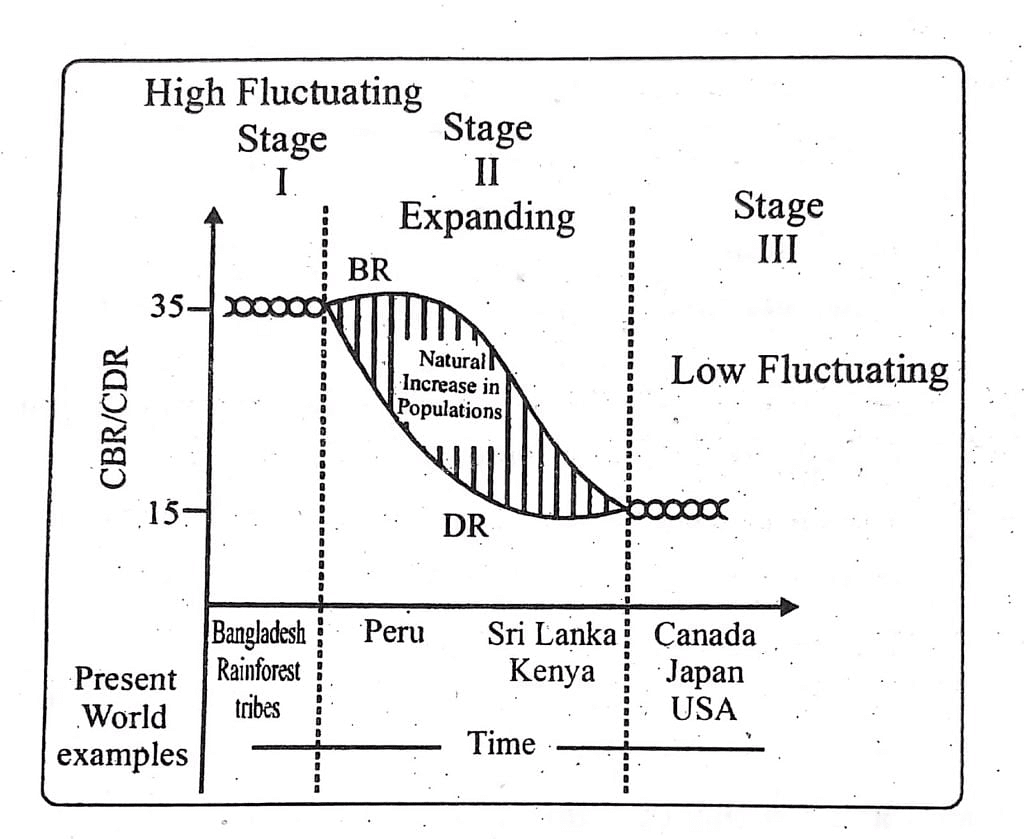 The Theory of Demographic Transition
The Theory of Demographic Transition
First Stage: High Birth and Mortality Rates
- This stage is characterised by slow population growth due to the large disparity between high birth and mortality rates in a backwards and impoverished society.
- Lack of education and ignorance about the benefits of smaller families contribute to high birth rates, while the lack of healthcare services leads to high death rates, resulting in a low population growth.
Second Stage: Population Explosion
- This stage marks the transition from a backwards to an advanced stage and is characterised by extremely high rates of population growth.
- High birth rates are attributed to the patriarchal nature of society, where males determine the number of children to be born and favour male children.
- Low death rates are a result of the availability of health and medical services, leading to a population explosion.
- A demographic dividend is created when the working population grows faster than the non-working population.
Third Stage: Stabilisation and Modest Growth
- In a developed society, the third (and final) stage is characterised by modest population growth, with both the mortality and birth rates slightly reduced.
- Low birth rates are due to individuals being informed and aware, and utilising birth control, which is widely accepted.
- The availability of health and medical services leads to low death rates, resulting in a low population.
Common Concepts and Indicators
- The majority of statistical ideas involve comparing two numbers stated as rates or ratios.
- One figure represents a specific statistic for a geographic area, while the other serves as a baseline for comparison.
Population Growth
- A population explosion occurs when birth rates are high and death rates are low.
- Birth rate is the number of live births per 1,000 people, influenced by cultural factors such as preference for male offspring.
- Death rate, or mortality rate, is the number of fatalities per 1,000 people.
- Natural growth rate is the difference between birth and mortality rates.
- Replacement level occurs when the current generation takes the place of the previous generation.
- Fertility rate measures live births among women aged 15-49.
- Infant mortality rate and maternal mortality rate are indicators of underdevelopment and poverty.
- Life expectancy and sex ratio are other demographic factors that affect population growth.
Sex Ratio
- Historically, there have been slightly more females than males.
- A slight sex ratio in favour of women can be attributed to infant girls having better resistance to illness and women living longer.
- Declining sex ratio can be caused by societal attitudes, abuse of girl children, and maternal mortality rates.
- Female infanticide and burning are more prevalent in prosperous states like Punjab and Haryana due to the expense of dowry and preference for male offspring.
- Pre-Natal Diagnostic Technique Act/Regulation and Prevention of Misuse Act was introduced in 1996 and enforced in 2003 to prevent determining the sex of a fetus before birth.
Age Distribution and Demographic Dividend
- Age distribution refers to the distribution of people by age.
- Demographic dividend occurs when the working population exceeds the dependent/nonworking population.
- Rising dependency ratio is concerning because it is more challenging for a smaller working population to support a larger dependent population.
- A declining dependency ratio can lead to economic expansion and prosperity.
- The demographic dividend can be preserved by improving education and raising awareness.
- Literacy is a key factor in maintaining the demographic dividend.
- Kerala has the highest literacy rate, while Rajasthan and northern states have the lowest rates.
Size and Growth of India's Population
Current Status of India's Population: As of 2025, India is the most populous country, with an estimated population of approximately 1.4 billion, based on projections from the 2011 Census (1.21 billion).
Historical Population Growth
- 1901-1951: The average annual population growth rate was 1.33%.
- 1911-1921: A negative growth rate of -0.03% occurred due to the 1918-19 influenza epidemic, which caused approximately 12.5 million deaths.
- Post-Independence (1961-1981): The growth rate increased to 2.2%. Although it has decreased in recent years, it remains high compared to other developing countries.
Demographic Transition
- Post-1921: The death rate decreased sharply, largely due to improved control over famines and epidemic diseases, while the birth rate declined more slowly.
- Factors in Death Rate Decline: Better management of famines and epidemics reduced mortality rates. Although significant diseases like malaria, tuberculosis, diarrhoea, and dysentery still pose challenges, overall health has improved.
- Factors in Famine Reduction: Improvements in agriculture, transportation, and state relief measures have greatly reduced famine-related deaths. Despite this, starvation deaths continue in some backwards regions, with initiatives like the Mahatma Gandhi National Rural Employment Guarantee Act addressing these issues.
- Slower Decline in Birth Rates: The birth rate has not declined as rapidly as the death rate due to sociocultural factors. However, factors like higher prosperity, reduced infant mortality, and increased education are contributing to lower birth rates.
Fertility Rates Across States
- Below Replacement Level TFR: States like Andhra Pradesh, Himachal Pradesh, Punjab, Tamil Nadu, and West Bengal have a Total Fertility Rate (TFR) of 1.7, below the replacement level. Kerala also has a TFR below replacement level, indicating potential future population decline.
- Higher TFR States: Bihar (3.3), Madhya Pradesh (2.8), Rajasthan (2.7), and Uttar Pradesh (3.1) have higher fertility rates, contributing significantly to population growth.
Birth Rates as of 2020
- National Average: As of recent estimates (e.g., SRS 2022), India’s crude birth rate is approximately 17-18.
- Rural vs Urban: The birth rate in rural areas is 21.1, while in urban areas it is 16.1.
- Highest Birth Rates: Bihar (25.5) and Uttar Pradesh (25.1) have the highest birth rates in the country.
Future Projections: Projections suggest that Bihar and Uttar Pradesh will account for nearly 50% of India's population growth up to 2041, with Uttar Pradesh alone contributing about 22% of this increase.
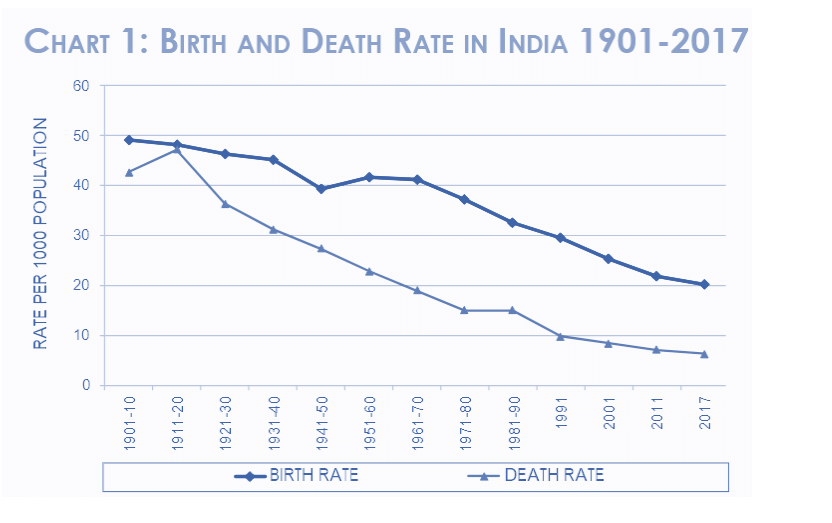 Birth and Death Rate in India: 1901-2017
Birth and Death Rate in India: 1901-2017
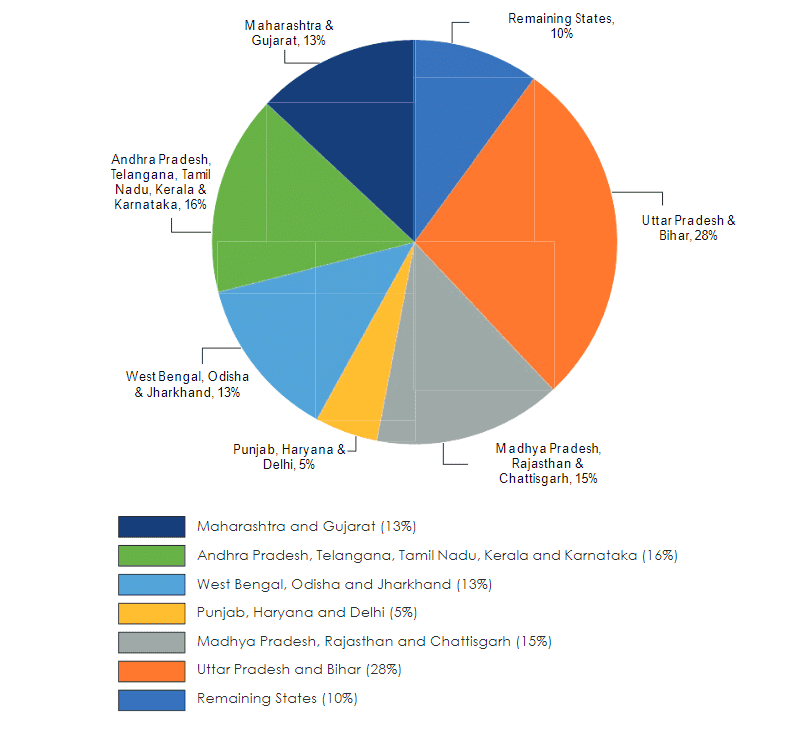 Regional Shares of Projected Population Growth upto 2041
Regional Shares of Projected Population Growth upto 2041
Age Structure of the Indian Population
India has a very young population, with the average age being lower than that of many other countries.
The share of the under-15 age group in the total population decreased from 42% in 1971 to 29% in 2011.
The share of the 15–59 age group increased from 53% to 63% over the same period.
The share of the 60+ age group is small but rising, from 5% to 7% between 1971 and 2011.
Demographic Dividend:
- India’s large working-age population compared to a smaller older population is seen as an advantage, similar to the past experience of East Asian economies and Ireland.
This demographic dividend can offer significant benefits but requires conscious exploitation through appropriate policies to be fully realised.
A population pyramid is a graphical representation that shows the distribution of a population by age and gender. It looks like a pyramid, with the age groups arranged on the vertical axis and the population size on the horizontal axis.
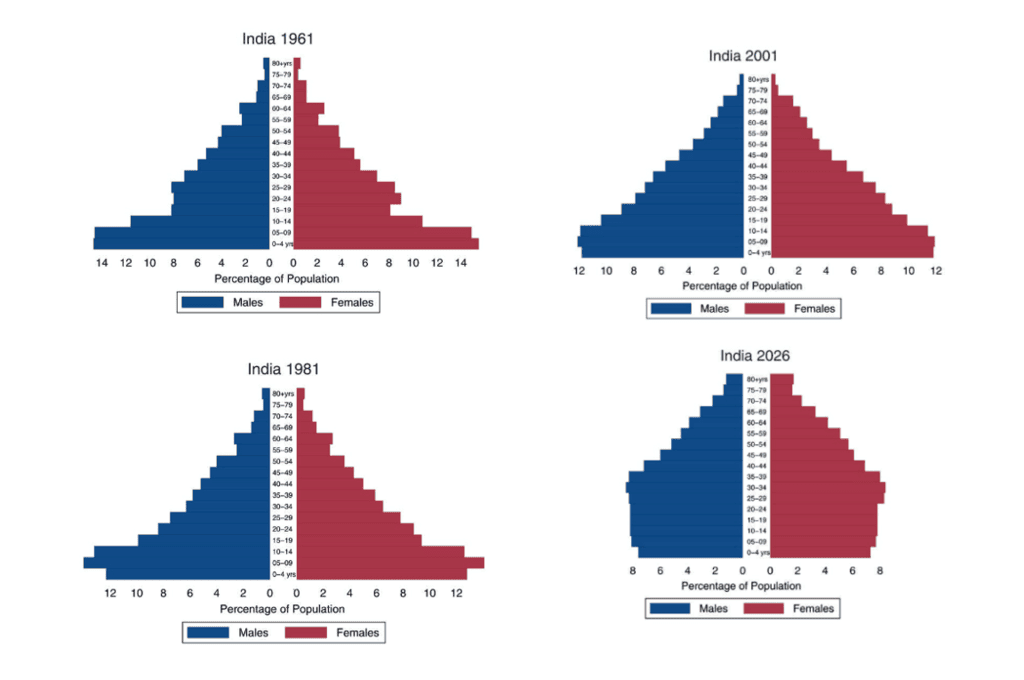 India's Population Pyramids: 1961, 1981, 2001 and 2026
India's Population Pyramids: 1961, 1981, 2001 and 2026
Regional Variations:
- Kerala is developing an age structure similar to that of developed countries.
- Uttar Pradesh has high proportions in younger age groups and lower proportions among the aged.
- India as a whole is in between, reflecting the diversity of states like Uttar Pradesh and Kerala.
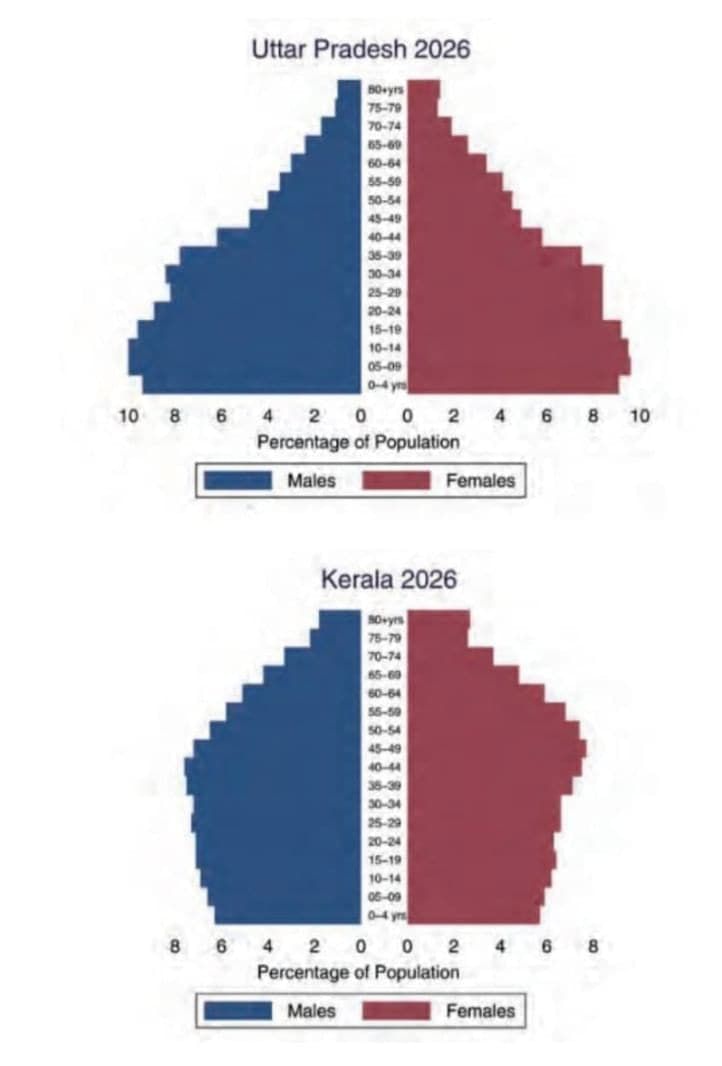
The Declining Sex-Ratio in India

Importance:
The sex ratio is a critical indicator of gender balance in a population. Historically, India had a sex ratio slightly in favor of females, with more females per 1,000 males.
Trends in Sex Ratio
1. Historical Decline:
- Early 20th Century: At the turn of the 20th century, India had a sex ratio of 972 females per 1,000 males.
- Late 20th Century: By the turn of the 21st century, the sex ratio had declined to 933 females per 1,000 males.
- 1961-1991: The sex ratio fell from 941 to an all-time low of 927.
- 2011 Census: The sex ratio increased slightly to 943 females per 1,000 males.
2. Child Sex Ratio:
The child sex ratio (age 0–6 years) has seen a sharper decline:
- 1991: 945 females per 1,000 males.
- 2001: Dropped to 927 females per 1,000 males.
- 2011: Further decreased to 919 females per 1,000 males, marking the first time it fell below the overall sex ratio in 2001.
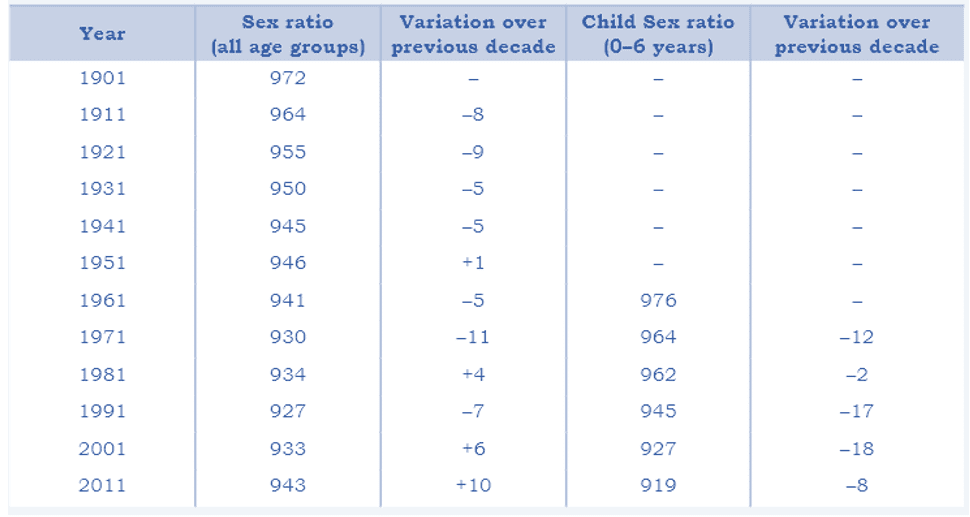 Declining Sex Ratio in India: 1901-2011
Declining Sex Ratio in India: 1901-2011
Regional Disparities in Child Sex Ratios
1. Lowest Ratios: Nine states and union territories have a child sex ratio below 900 females per 1,000 males, with Haryana having the lowest at 793. Other regions with very low child sex ratios include Punjab, Jammu & Kashmir, Delhi, Chandigarh, Uttarakhand, and Himachal Pradesh.
2. Below National Average: States like Uttar Pradesh, Daman & Diu, Himachal Pradesh, Lakshadweep, and Madhya Pradesh have ratios below 925.
3. Above National Average but Below 970: Large states such as West Bengal, Assam, Bihar, Tamil Nadu, Andhra Pradesh, and Karnataka fall in this range. Kerala has a sex ratio of 964, while Arunachal Pradesh has the highest at 972.
Reasons for Decline in Sex Ratio
1. Neglect and Higher Death Rates of Girls: Increased neglect of girl babies leads to higher mortality rates among female infants.
2. Sex-Selective Abortions and Female Infanticide: The misuse of prenatal diagnostic techniques, such as sonograms, to identify and abort female fetuses has significantly contributed to the decline.
3. Economic Prosperity and Sex Selection:
- Low child sex ratios are often seen in economically prosperous regions like Maharashtra, Punjab, Haryana, Chandigarh, and Delhi. This suggests that the issue is not solely due to poverty or ignorance.
- Some prosperous families prefer fewer children and may use ultrasound technology to choose the sex of their child.
Legal and Policy Measures
1. Legal Action: The Prenatal Diagnostic Techniques (Regulation and Prevention of Misuse) Act, implemented in 1996 and strengthened in 2003, aims to curb the misuse of ultrasound technology for sex selection.
2. Government Initiatives: The Government of India has introduced the ‘Beti-Bachao, Beti-Padhao’ program to improve the child sex ratio and address gender imbalances, reflecting ongoing efforts to tackle these issues through policy initiatives.
Literacy
Literacy is a key prerequisite to education and serves as a powerful tool for empowerment. It enables individuals to:
- Explore a wider range of career options.
- Participate actively in the knowledge economy.
- Increase health awareness.
- Contribute more fully to the cultural and economic well-being of their communities.

Trends in Literacy Rates
Post-Independence Improvement: Literacy levels in India have improved significantly since independence, with nearly two-thirds of the population now literate. However, the rate of improvement has struggled to keep pace with the rapid growth of the Indian population.
Gender Disparities:- The literacy rate for women is 16.3% lower than that for men.
- Female literacy is rising faster than male literacy, with a 10.4% increase for women between 2001 and 2011, compared to a 7.6% increase for men.
- From 2001 to 2011, overall literacy increased by approximately 8%, with male literacy rising about 5% and female literacy about 10%.
Variations Across Regions and Social Groups
1. Social Disparities: Historically disadvantaged communities, such as Scheduled Castes and Scheduled Tribes, have lower literacy rates, with female literacy in these groups even lower.
2. Regional Variations: States like Kerala are approaching universal literacy. States like Bihar have much lower literacy rates, highlighting significant regional disparities.
Implications of Literacy Inequality
Reproduction of Inequality: Inequalities in literacy rates contribute to the perpetuation of inequality across generations. Illiterate parents often face challenges in providing their children with quality education, further entrenching existing disparities.
Rural - Urban Differences
Rural vs. Urban Population in India
Rural Population: Historically, the majority of India’s population has lived in rural areas. Census of India 2011: 68.8% of the population resides in rural areas, while 31.2% live in urban areas.
Urban Population Trends:
- Early 20th Century: Urban population was around 11%.
- Early 21st Century: Increased to approximately 28%.
Changes and Trends
1. Economic and Social Shifts: Modern development has diminished the economic and social importance of the agrarian-rural lifestyle compared to the industrial-urban way of life. Agriculture now contributes about one-sixth of India's Gross Domestic Product (GDP).
2. Rural to Urban Migration: Many rural residents are transitioning from agriculture to non-farm occupations such as transport services, business enterprises, and craft manufacturing. Some individuals commute to urban centres for work while continuing to live in villages.
3. Influence of Modern Media: Mass media and communication are bringing urban lifestyles and consumption patterns to rural areas, creating new desires and aspirations. Improved mass transit and communication are bridging the gap between rural and urban areas.
Urbanisation and Migration
1. Urban Attraction: Urban areas serve as magnets for rural populations seeking employment opportunities. Migration is accelerated by the decline of common property resources like ponds, forests, and grazing lands, which previously supported rural livelihoods.
2. Challenges in Rural Areas: The decline in common resources has increased hardship in rural areas. Cities offer social advantages and anonymity, making them attractive destinations for marginalised groups.
3. Growth of Large Cities: The largest cities, or metropolises, are growing rapidly, attracting migrants from rural areas and smaller towns.
Current Statistics: There are 5,161 towns and cities in India. Over two-thirds of the urban population lives in 27 cities with populations exceeding one million.
Urban vs. Rural Dynamics
- Infrastructure Strain: Rapid growth in large cities is outpacing the development of urban infrastructure.
- Political Power: Despite urbanisation, rural areas continue to hold significant political power.
Population Policy in India
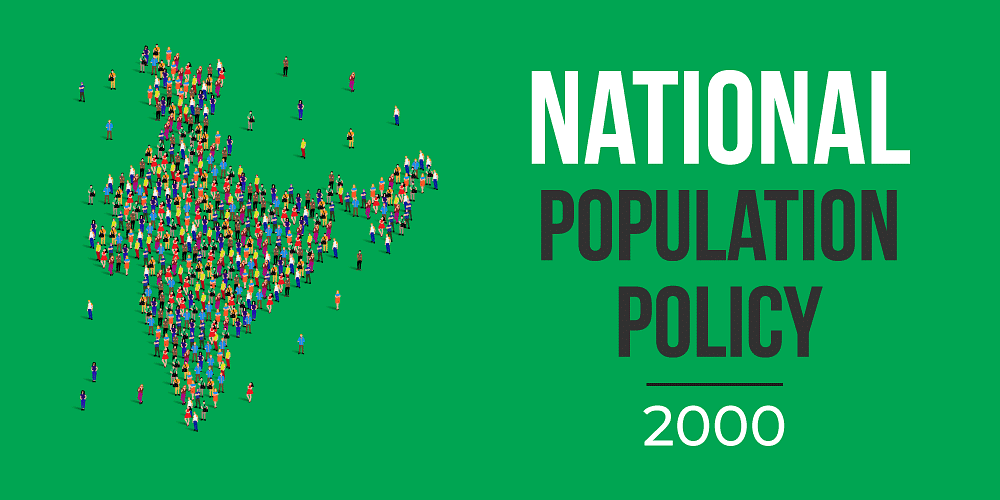
- Population dynamics are crucial for developmental prospects and well-being, especially in developing countries.
- India has had an official population policy since 1952.
- The National Family Planning Programme was created to influence population growth, improve public health, and increase awareness.
- Significant progress in population management has been achieved over the past fifty years.
- During the National Emergency (1975–76), there was a setback due to a coercive mass sterilization campaign, involving forced sterilizations and widespread opposition.
- After the Emergency, the programme was renamed to the National Family Welfare Programme, which emphasized non-coercive methods and broader socio-demographic objectives.
- The National Population Policy 2000 introduced new guidelines and targets, later incorporated into the National Health Policy 2017.
- Population policies show that while the state can influence demographic change, many factors, particularly those related to human fertility, are influenced by broader economic, social, and cultural changes.
FAQs on The Demographic Structure of the Indian Society Class 12 Sociology
| 1. What are some common concepts and indicators related to the demographic structure of Indian society? |  |
| 2. How has the sex ratio in India been declining over the years? |  |
| 3. What is the significance of the age structure of the Indian population? |  |
| 4. How do rural-urban differences impact the demographic structure of Indian society? |  |
| 5. What are some key components of population policy in India? |  |

















